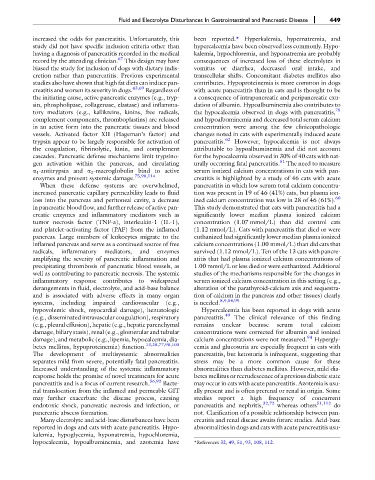Page 461 - Fluid, Electrolyte, and Acid-Base Disorders in Small Animal Practice
P. 461
Fluid and Electrolyte Disturbances In Gastrointestinal and Pancreatic Disease 449
increased the odds for pancreatitis. Unfortunately, this been reported.* Hyperkalemia, hypernatremia, and
study did not have specific inclusion criteria other than hypercalcemia have been observed less commonly. Hypo-
having a diagnosis of pancreatitis recorded in the medical kalemia, hypochloremia, and hyponatremia are probably
record by the attending clinician. 67 This design may have consequences of increased loss of these electrolytes in
biased the study for inclusion of dogs with dietary indis- vomitus or diarrhea, decreased oral intake, and
cretion rather than pancreatitis. Previous experimental transcellular shifts. Concomitant diabetes mellitus also
studies also have shown that high fat diets can induce pan- contributes. Hypoproteinemia is more common in dogs
creatitis and worsen its severity in dogs. 43,69 Regardless of with acute pancreatitis than in cats and is thought to be
the initiating cause, active pancreatic enzymes (e.g., tryp- a consequence of intrapancreatic and peripancreatic exu-
sin, phospholipase, collagenase, elastase) and inflamma- dation of albumin. Hypoalbuminemia also contributes to
tory mediators (e.g., kallikreins, kinins, free radicals, the hypocalcemia observed in dogs with pancreatitis, 78
complement components, thromboplastins) are released and hypoalbuminemia and decreased total serum calcium
in an active form into the pancreatic tissues and blood concentration were among the few clinicopathologic
vessels. Activated factor XII (Hageman’s factor) and changes noted in cats with experimentally induced acute
trypsin appear to be largely responsible for activation of pancreatitis. 62 However, hypocalcemia is not always
the coagulation, fibrinolytic, kinin, and complement attributable to hypoalbuminemia and did not account
cascades. Pancreatic defense mechanisms limit trypsino- for the hypocalcemia observed in 30% of 40 cats with nat-
gen activation within the pancreas, and circulating urally occurring fatal pancreatitis. 51 The need to measure
a 1 -antitrypsin and a 2 -macroglobulin bind to active serum ionized calcium concentrations in cats with pan-
enzymes and prevent systemic damage. 75,90,114 creatitis is highlighted by a study of 46 cats with acute
When these defense systems are overwhelmed, pancreatitis in which low serum total calcium concentra-
increased pancreatic capillary permeability leads to fluid tion was present in 19 of 46 (41%) cats, but plasma ion-
loss into the pancreas and peritoneal cavity, a decrease ized calcium concentration was low in 28 of 46 (61%). 60
in pancreatic blood flow, and further release of active pan- This study demonstrated that cats with pancreatitis had a
creatic enzymes and inflammatory mediators such as significantly lower median plasma ionized calcium
tumor necrosis factor (TNF-a), interleukin-1 (IL-1), concentration (1.07 mmol/L) than did control cats
and platelet-activating factor (PAF) from the inflamed (1.12 mmol/L). Cats with pancreatitis that died or were
pancreas. Large numbers of leukocytes migrate to the euthanized had significantly lower median plasma ionized
inflamed pancreas and serve as a continued source of free calcium concentrations (1.00 mmol/L) than did cats that
radicals, inflammatory mediators, and enzymes survived (1.12 mmol/L). Ten of the 13 cats with pancre-
amplifying the severity of pancreatic inflammation and atitis that had plasma ionized calcium concentrations of
precipitating thrombosis of pancreatic blood vessels, as 1.00 mmol/L or less died or were euthanized. Additional
well as contributing to pancreatic necrosis. The systemic studies of the mechanisms responsible for the changes in
inflammatory response contributes to widespread serum ionized calcium concentration in this setting (e.g.,
derangements in fluid, electrolyte, and acid-base balance alteration of the parathyroid-calcium axis and sequestra-
and is associated with adverse effects in many organ tion of calcium in the pancreas and other tissues) clearly
systems, including impaired cardiovascular (e.g., is needed. 8,9,54,99
hypovolemic shock, myocardial damage), hematologic Hypercalcemia has been reported in dogs with acute
(e.g., disseminated intravascular coagulation), respiratory pancreatitis. 49 The clinical relevance of this finding
(e.g., pleural effusion), hepatic (e.g., hepatic parenchymal remains unclear because serum total calcium
damage, biliary stasis), renal (e.g., glomerular and tubular concentrations were corrected for albumin and ionized
damage), and metabolic (e.g., lipemia, hypocalcemia, dia- calcium concentrations were not measured. 94 Hypergly-
13,28,77,98,103
betes mellitus, hypoproteinemia) function. cemia and glucosuria are especially frequent in cats with
The development of multisystemic abnormalities pancreatitis, but ketonuria is infrequent, suggesting that
separates mild from severe, potentially fatal pancreatitis. stress may be a more common cause for these
Increased understanding of the systemic inflammatory abnormalities than diabetes mellitus. However, mild dia-
response holds the promise of novel treatments for acute betes mellitus or recrudescence of a previous diabetic state
pancreatitis and is a focus of current research. 56,92 Bacte- may occur in cats with acute pancreatitis. Azotemia is usu-
rial translocation from the inflamed and permeable GIT ally present and is often prerenal or renal in origin. Some
may further exacerbate the disease process, causing studies report a high frequency of concurrent
endotoxic shock, pancreatic necrosis and infection, or pancreatitis and nephritis, 32,72 whereas others 51,112 do
pancreatic abscess formation. not. Clarification of a possible relationship between pan-
Many electrolyte and acid-base disturbances have been creatitis and renal disease awaits future studies. Acid-base
reported in dogs and cats with acute pancreatitis. Hypo- abnormalities in dogs and cats with acute pancreatitis usu-
kalemia, hypoglycemia, hyponatremia, hypochloremia,
hypocalcemia, hypoalbuminemia, and azotemia have *References 32, 49, 51, 93, 108, 112.

